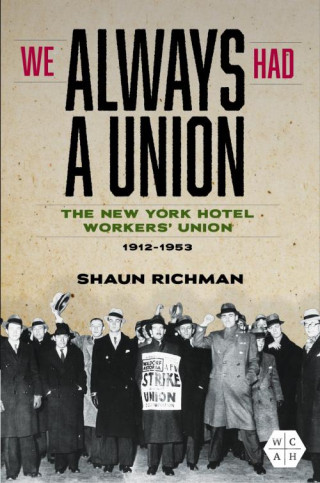The Communists, for a time, were tolerated in the older, more conservative labor federation, particularly during World War II when Allied cooperation between the US and Soviet governments supercharged Popular Front alliances. HERE Local 6, for example, raised so much money for Labor’s War Chest, which made charitable contributions of food and clothing for soldiers’ families, that AFL first vice president Matthew Woll, an inveterate anti-communist, publicly commended them for contributing their 1944 fundraising haul (second only to that of the entire International Ladies Garment Workers’ Union). Also in 1944, when Hotel Trades Council president Jay Rubin and HERE Local 6 president Michael J. Obermeier published a biography of HERE president Edward Flore that was not shy about celebrating his open alliance with the Communists, AFL leaders William Green and George Meany provided blurbs for the book jacket.
By 1945, the Communists in HERE, like those who rose into positions of power and influence within the CIO, were broadly accepted as both talented organizers and as labor statesmen. Unlike many left-led CIO unions, however, the Communists’ leadership in the New York hospitality industry predated their affiliation with the AFL, and in many ways the bonds between rank-and-filers and local leadership were stronger than those of the house of labor.
Not a Witch Hunt
The unity of the Popular Front was broken with dizzying speed by the Cold War. The AFL embraced Communist containment. In 1946, fifty thousand people marched in the first May Day parade since 1941. The AFL forbade its affiliates from participating, on pain of suspension or worse. Local 6 got around the dictate by having its members march as individuals, without union banners. This small rebellion did not go unnoticed. In October 1946, at the AFL’s annual convention, the federation’s president, William Green, denounced its rival “Communist-dominated” CIO before delegates passed a strongly worded anti-communist resolution.
Also in 1946, Local 6’s education director, Charlotte Stern, was indicted for contempt of Congress, along with the board of the nonprofit Joint Anti-Fascist Refugee Committee for refusing a House Un-American Activities Committee subpoena for “all books, ledgers, records, and papers relating to the receipt and disbursement of money.”
The fallout began with a power struggle in the New York Local Joint Executive Board (LJEB), the umbrella body of all HERE locals in the city. Local 6, along with CP-led Waiters Local 1 and Cooks Local 89, dominated the LJEB through numerical membership strength. The other dozen locals were led by rival social democrats, Lovestoneites, Trotskyists, and even some old-fashioned conservatives. These local leaders objected to the use of staff and resources on Communist front activities and tried — and failed — to elect more nonpartisan officers.
